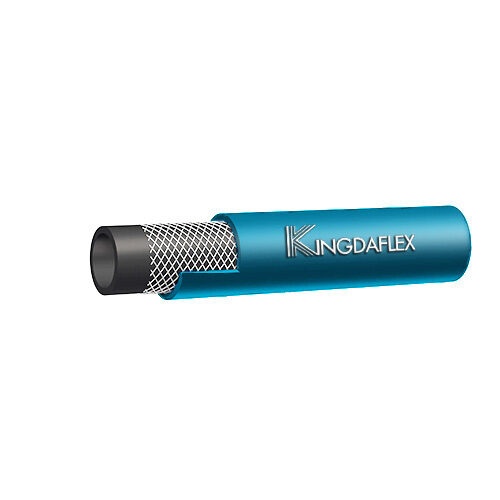Welding is a crucial process in various industries, such as construction, manufacturing, and automotive. It involves joining two or more metal pieces using high heat to melt and fuse them together.
While welding is an essential skill, it is equally important to prioritize safety throughout the process. One crucial safety aspect is the proper identification of welding components, including the oxygen hose.
In this article, we will explore the significance of the oxygen hose in welding and understand the color coding used to identify it.
What is Welding?
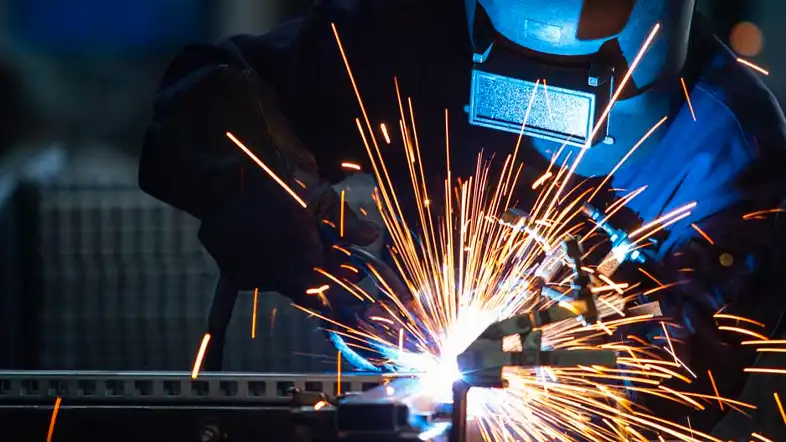
Welding is a fabrication process that involves joining two or more metal pieces together using high heat to melt and fuse them. It is a fundamental technique used in various industries, such as construction, manufacturing, shipbuilding, automotive, and aerospace, among others.
The process of welding requires several essential components and tools. One crucial element is the welding machine, also known as a welder or welding power source. The welding machine generates an electric current or an intense flame, depending on the welding method used.
In arc welding, the most common type of welding, the welding machine produces an electric arc between an electrode and the base metal. The heat generated by the arc causes the metal to melt, and as the molten metal cools and solidifies, it fuses the pieces together, forming a strong and permanent bond.
Another critical component in welding is the electrode. The electrode acts as a conductor and is essential in completing the electric circuit necessary for generating the arc. Electrodes come in various types, including consumable and non-consumable electrodes, each suited for specific welding applications.
Get an instant quote
To contact us right now to get an instant quote if you are are interested in the products mentioned in this blog. Our team will give you the best reply within 2 working hours.
Depending on the welding method and the type of metal being welded, a shielding gas or flux may be used. Shielding gas, such as argon or carbon dioxide, creates an atmosphere around the welding area, protecting the molten metal from atmospheric contamination, which could weaken the weld. Flux is a chemical substance used in certain welding processes to produce a protective layer on the welding area, preventing oxidation and improving the quality of the weld.
Welding techniques can vary, and each has its advantages and applications. Some common welding methods include:
- Shielded Metal Arc Welding (SMAW): Also known as stick welding, SMAW is widely used and suitable for a variety of metals and environments.
- Gas Metal Arc Welding (GMAW): Commonly referred to as MIG (Metal Inert Gas) or MAG (Metal Active Gas) welding, GMAW uses a continuous wire electrode and shielding gas.
- Gas Tungsten Arc Welding (GTAW): Known as TIG (Tungsten Inert Gas) welding, GTAW uses a non-consumable tungsten electrode and shielding gas.
- Flux-Cored Arc Welding (FCAW): FCAW uses a flux-cored wire electrode, eliminating the need for a shielding gas.
- Submerged Arc Welding (SAW): SAW involves feeding a continuous wire electrode into the weld area while covering it with a layer of granular flux.
Welding is a critical skill and profession that requires proper training, knowledge of different metals and welding techniques, and a strong emphasis on safety. Welders must wear protective gear, including welding helmets, gloves, and clothing, to shield themselves from the intense heat and harmful fumes generated during the welding process.
Welding is a versatile and indispensable process that contributes to the creation and maintenance of numerous structures and products, making it a cornerstone of modern industry and construction.
The Importance of Safety in Welding
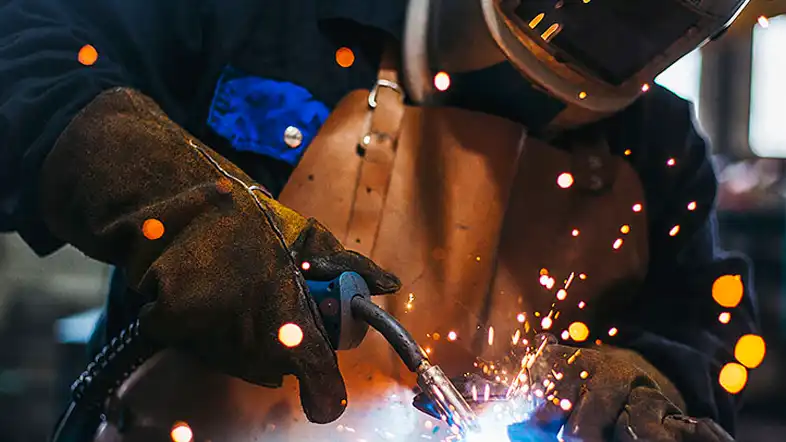
Safety is of paramount importance in welding due to the inherent risks and hazards associated with the process. Welding involves high temperatures, intense light, harmful fumes, and potential electric shock, making it crucial for welders to prioritize safety measures at all times. Here are some key reasons why safety is essential in welding:
- Protection Against Burns and Fires: Welding generates extremely high temperatures, and welders are at risk of sustaining severe burns if not properly protected. Protective clothing, such as flame-resistant jackets, gloves, and welding helmets with appropriate lenses, is essential to shield welders from heat and sparks. Additionally, welding can lead to fires if proper precautions are not taken, making fire-resistant materials and fire extinguishers vital safety equipment in welding areas.
- Preventing Eye Injuries: The intense light produced during welding can cause serious damage to the eyes, leading to permanent vision problems or blindness. Welding helmets with auto-darkening lenses are critical to safeguard welders’ eyes from harmful UV and infrared radiation. Proper eye protection ensures that welders can work safely and maintain good vision in the long term.
- Minimizing Exposure to Harmful Fumes and Gases: Welding generates hazardous fumes and gases, depending on the type of metal being welded and the welding process used. These fumes can lead to respiratory issues and long-term health problems if inhaled regularly. Adequate ventilation in the welding area, as well as the use of respiratory protection like respirators or air-supplied helmets, helps reduce the risk of exposure to harmful fumes.
- Preventing Electric Shock: Welding machines use electricity to generate the welding arc, which poses a risk of electric shock to welders if not handled correctly. Insulated welding cables, well-maintained equipment, and proper grounding of welding machines are essential safety measures to prevent electric shock incidents.
- Avoiding Welding Flash and Arc Eye: Welding flash, also known as arc flash or arc eye, occurs when the intense light from the welding arc damages the cornea and conjunctiva of the eyes. This painful condition can be prevented by wearing proper eye protection, such as welding helmets with appropriate shading.
- Avoiding Welding Fume Fever: Inhalation of certain welding fumes, such as zinc or galvanized metal fumes, can cause a condition known as “metal fume fever,” characterized by flu-like symptoms. Proper ventilation and respiratory protection are essential in preventing this condition.
- Minimizing Noise Exposure: Welding can produce loud noises, which can lead to hearing damage over time. Wearing hearing protection, such as earmuffs or earplugs, helps reduce the risk of noise-induced hearing loss.
- Preventing Welding-Related Accidents: Welding in industrial settings involves various potential hazards, including falling objects, slips, trips, and falls. Keeping the work area organized, using appropriate barriers, and following safety protocols significantly reduce the risk of accidents.
- Promoting Safe Work Practices: Proper training and education in welding safety are crucial for welders to understand potential risks and learn safe work practices. Regular safety training ensures that welders are aware of the latest safety guidelines and practices in the industry.
In conclusion, safety is a fundamental aspect of welding that cannot be overlooked. Welders must prioritize safety by using appropriate personal protective equipment, following safety protocols, and being vigilant about potential hazards. By doing so, they can protect themselves and others while producing high-quality welds in a safe and secure working environment.
What Is the Oxygen Hose?
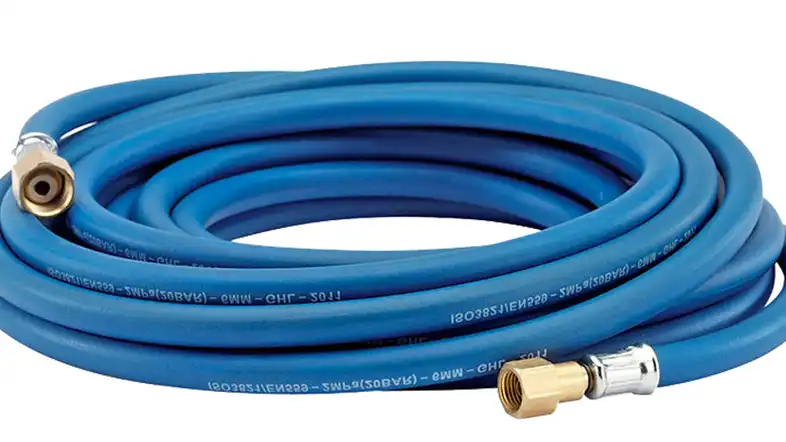
The oxygen hose is a critical component in welding processes that involve the use of oxy-fuel gases, such as oxy-acetylene welding and cutting. It plays a vital role in supplying oxygen to support combustion during the welding or cutting operation. The oxygen hose is designed to withstand the high-pressure flow of oxygen from the gas source to the welding torch or cutting torch.
In oxy-fuel welding, the oxygen hose connects the oxygen cylinder to the welding torch. When the welder opens the torch’s oxygen valve, high-pressure oxygen flows through the hose and exits the torch tip. Simultaneously, a fuel gas, typically acetylene, propane, or natural gas, is fed into the torch through another hose. The oxygen and fuel gas mix at the torch tip and are ignited to create an intense flame with temperatures reaching thousands of degrees Celsius.
This high-temperature flame is used to melt and fuse metals together during welding or to cut through metals in oxy-fuel cutting processes. The oxygen hose plays a crucial role in controlling the amount of oxygen delivered to the flame, ensuring the appropriate combustion and temperature needed for effective welding or cutting.
The oxygen hose is typically color-coded to distinguish it from other hoses used in welding setups. The American Welding Society (AWS) has established standard color codes for welding hoses. The oxygen hose is commonly identified by its bright green color, making it easily recognizable among other hoses connected to the welding equipment.
Due to the high-pressure and potentially hazardous nature of the gases flowing through the oxygen hose, it is essential to handle and maintain it with care. Regular inspections are conducted to check for any signs of damage or wear that could compromise its integrity. Proper storage and handling are also critical to prevent kinks or bends that may restrict the flow of oxygen.
In conclusion, the oxygen hose is a vital component in oxy-fuel welding and cutting processes. It supplies high-pressure oxygen to support the combustion required for these operations. The correct identification and proper handling of the oxygen hose are crucial for the safety and effectiveness of welding and cutting activities.
What Color is an Oxygen Hose?
Oxygen hoses typically come in blue.
This color is a widely recognized standard that helps to easily identify oxygen equipment and prevent accidental mixing with other gases. However, it’s important to note that there might be variations in color depending on the specific manufacturer or application.
Oxygen and Acetylene Hose Color
Oxygen hoses are typically blue, while acetylene hoses are typically red.
This color coding is a standard safety practice that helps to easily identify and differentiate between these two gases.
Using the correct hose for each gas is crucial to prevent accidents and ensure safe operation.
What Color is the Oxygen Hose When Welding
The green color of the oxygen hose in welding is a critical safety measure.
It’s part of a standardized color code system designed to prevent accidental mixing of gases. This is particularly important in welding, where the wrong combination of gases can lead to dangerous situations, such as explosions or the production of toxic fumes.
Why Green for Oxygen Hose when Welding?
- Universal Recognition: Green is universally recognized as the color associated with oxygen. This ensures that anyone working with welding equipment, regardless of their language or background, can easily identify the oxygen hose.
- Prevention of Accidents: By clearly distinguishing the oxygen hose from other gas hoses (like the acetylene hose, which is typically red), the risk of accidentally connecting the wrong gas to the torch is significantly reduced.
- Safety Regulations: Adherence to this color code is often mandated by safety regulations and industry standards, ensuring a consistent and safe approach to welding operations.
Other Gas Hose Colors
- Acetylene: Red
- Propane: Gray
- Nitrogen: Black
- Carbon Dioxide: Blue
Remember: Always double-check the color codes and labels on the gas cylinders before connecting them to the hoses to ensure you’re using the correct gases for your welding process.
Welding Oxygen Hose Color
The welding oxygen hose is typically color-coded for easy identification and safety purposes. In most standard color-coding systems, the oxygen hose is designated by the color green.
The American Welding Society (AWS) has established color codes for welding hoses to help welders quickly and accurately identify the specific gases carried by each hose. The use of distinct colors for different gases minimizes the risk of confusion and potential accidents during welding operations.
As per the AWS color-coding system, the colors commonly used for welding hoses are:
- Blue: The green hose is used to indicate the oxygen hose. Oxygen is a vital component in oxy-fuel welding and cutting processes, where it supports the combustion needed for welding and cutting metals.
- Red: The red hose designates the acetylene hose. Acetylene is a common fuel gas used in oxy-fuel welding and cutting setups. It combines with oxygen to create a high-temperature flame for melting metals.
- Blue: The blue hose is used for inert gases, such as argon and helium, used in certain welding processes like gas tungsten arc welding (GTAW) or TIG welding.
- Orange: The orange hose indicates hoses carrying fuel gases other than acetylene. This can include gases like propane, propylene, or natural gas, depending on the specific application.
- Black: The black hose is used for hoses carrying shielding gases like carbon dioxide, typically used in gas metal arc welding (GMAW) or MIG welding.
Following these color codes is essential to ensure proper identification of welding hoses and to prevent any mix-ups that could lead to potentially hazardous situations.
Remember, safety is paramount in welding operations, and correct identification and handling of hoses, especially the oxygen hose, are critical to maintaining a safe working environment for welders and others involved in the welding process.
Of course, you can choose to customize your desired color, blue, and green is the most popular color code in the oxygen hose industry.
Standard Color Codes for Oxygen Hoses
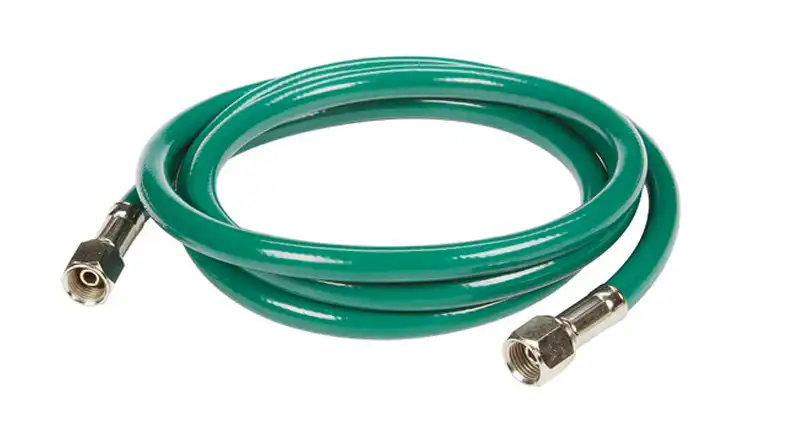
The Standard Color Codes for Oxygen Hoses are a set of guidelines established by the American Welding Society (AWS) to ensure the safe identification of welding hoses used in various processes, particularly in oxy-fuel welding and cutting. These color codes help welders and other professionals working with welding equipment to quickly and easily identify the specific gas carried by each hose, thereby minimizing the risk of accidents and ensuring a safe working environment.
In the context of oxygen hoses, the standard color code designates the hose to be green. Therefore, the oxygen hose used in welding processes is typically identified by its bright green color. This color is distinct and easily recognizable, making it less likely for welders to confuse the oxygen hose with hoses carrying other gases.
By adhering to these color codes, welders can ensure that they use the correct hose for a specific gas, such as oxygen, acetylene, argon, or other fuel gases. Using the wrong hose can lead to hazardous situations, especially when dealing with oxygen, which supports combustion. For instance, if a welder mistakenly connects an oxygen hose to a fuel gas supply, it can create a highly flammable atmosphere, increasing the risk of fire and explosions.
The AWS color coding system is widely accepted and followed internationally, promoting a standardized approach to hose identification. It is essential for welders and those working in welding-related industries to be familiar with these color codes to maintain a safe and accident-free workplace.
However, it is crucial to note that while color-coding is an effective method of hose identification, it should not be solely relied upon. Proper labeling and marking of hoses are equally important to ensure that the correct gas is being used. Regular inspections and maintenance of hoses are also essential to ensure their integrity and safety.
The Standard Color Codes for Oxygen Hoses, with oxygen hoses designated as green, are a critical aspect of welding safety. They enable welders to identify the oxygen hose easily, ensuring that the right hose is used for the appropriate gas and minimizing the risk of accidents during welding operations.
The Significance of Differentiating Hoses
Properly identifying the oxygen hose is crucial for safe welding practices. Using the wrong hose or confusing it with another gas hose, such as acetylene, can have severe consequences. Oxygen, when combined with flammable substances, can increase the risk of fire and explosions. Therefore, correctly distinguishing the oxygen hose is vital for the well-being of the welder and the overall safety of the welding environment.
Proper Labeling and Marking of Hoses
Proper labeling and marking of hoses are essential safety measures in welding practices. Clear and prominent labeling of welding hoses is crucial to ensure that the correct hose is used for specific gases, such as oxygen, acetylene, or argon. This practice helps prevent potential hazards and accidents that may arise from using the wrong hose.
Here are some key points regarding the importance of proper labeling and marking of hoses:
- Identification of Gas Content: Welding hoses should be labeled with the name of the gas they carry, such as “Oxygen,” “Acetylene,” “Argon,” or any other relevant gas. This allows welders to quickly identify the purpose of each hose and use the appropriate one for their welding process.
- Pressure Rating: The hoses should also display their pressure rating, indicating the maximum pressure they can safely handle. This information is crucial as using a hose beyond its pressure limit can lead to hose failure and potential accidents.
- Hose Integrity: Proper labeling and marking of hoses can help ensure that they are in good condition. If a hose’s label is missing, illegible, or damaged, it should be replaced immediately to avoid any risks.
- Distinctive Colors: In addition to color-coding, hoses can be further marked with colored bands or stripes to provide additional visual cues for identifying gases. For instance, oxygen hoses may have a green band, and acetylene hoses may have a red band.
- Safety Compliance: Properly labeled hoses contribute to compliance with safety regulations and standards set by organizations like the American Welding Society (AWS). Following these guidelines helps maintain a safe working environment.
- Preventing Cross-Contamination: Marked hoses reduce the risk of cross-contamination, where one gas may inadvertently mix with another, causing potential hazards. This is particularly critical when handling oxygen, which can intensify combustion.
- Regular Inspection: Welders should regularly inspect the hoses and their labels to ensure their legibility and accuracy. Inspections should be part of routine maintenance to identify any signs of wear, damage, or deterioration.
- Training and Awareness: Educating welders and personnel about the significance of proper hose labeling and marking is essential. They should be aware of the consequences of using the wrong hose and the importance of adhering to safety protocols.
Proper labeling and marking of hoses are vital components of welding safety. These measures help prevent accidents, ensure the correct gas is used for each welding process, and comply with industry standards and regulations. Welders and all individuals involved in welding operations must prioritize the clear identification of hoses to maintain a safe and secure working environment.
Conclusion
In conclusion, the oxygen hose plays a critical role in welding, supplying oxygen for oxy-fuel welding processes. Identifying the correct oxygen hose is crucial for maintaining a safe welding environment and preventing potential accidents. Adhering to the standard color codes and ensuring proper labeling of hoses are vital steps in prioritizing safety during welding operations.
FAQs
Are there different colors for other welding hoses?
Yes, welding hoses for different gases have specific colors designated by the American Welding Society (AWS). For instance, acetylene hoses are marked in red.
Can using the wrong hose cause an explosion?
Yes, using the wrong hose, especially for oxygen, can lead to a dangerous increase in oxygen concentration, potentially causing an explosion when combined with flammable substances.
How often should I inspect my welding hoses?
Regular inspections are essential. It is recommended to inspect hoses before each use and conduct a more thorough examination periodically.
Is there an alternative to color-coding for hose identification?
While color-coding is highly effective, proper labeling and marking of hoses are additional measures to ensure correct identification.
Are there different hose standards in different countries?
Yes, different countries may have their own hose color-coding standards. However, the AWS color-coding system is widely recognized and followed internationally.

